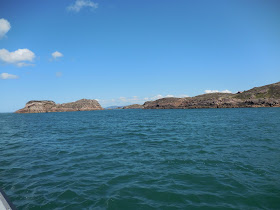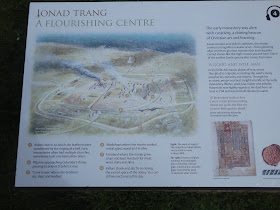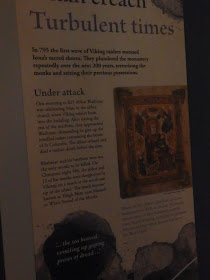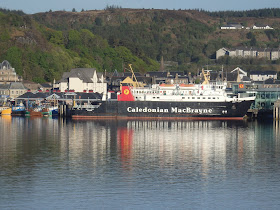 |
| There's a cruise ship in the bay. |
 |
| Better view of the shore where our B&B is located. The boat is the tender that is transporting passengers from the cruise ship into town. |
 |
| Oban Lifeboat Station and lifeboat - orange top and blue hull. |
 |
| Saw this helicopter taking off. All I could make out on the side was PDG Helicopters. The website for them was totally unhelpful but they contract out their services. Don't think they do tours. |
 |
| Large home further down the bay. |
 |
| Finally getting out beyond the bay. I think that is the island of Mull in the distance. |
 |
| Memorial on a peninsula. |
 |
| Small island in the bay with a smaller Caledonian-MacBrayne ferry. |
 |
| Headed to the island of Mull, second largest of the Inner Hebrides. Mull has nearly 300 miles of coastline and was once a 10,000' mountain. The tallest point now is Ben More at 3,169 foot. |
 |
| We passed Duart Castle on our way to the Mull port town of Craignure. Once home of the Chief of Clan Maclean, it is now open for tours. |
 |
| Made it back to land. |
 |
| Then we got on a bus for the 1 1/2 hr ride across the isle of Mull. This is a double decker bus. |
 |
| The bus driver narrated the drive. He pointed out the oyster farms in one of the tidal lochs. |
 |
| The herds of cattle in Scotland always seem to be made up of several different colors. |
 |
| The some of the island is planted with commercial crops of Sitka Spruce. |
 |
| Most of the mountainside is bare but you can see the grove of Sitka spruce |
 |
| Look close to see the waterfall. |
 |
| Large groves of Sitka spruce |
 |
| There are passing spots but the road is barely wider than the bus. |
 |
| Loch Beg |
 |
| Of course there are sheep everywhere. |
 |
| The yellow gorse is a spiny shrub that grows all over Scotland. |
 |
| Pulling into Fionnphort. |
 |
| The Iona Abbey as seen from the ferry. Although not the original abbey that St. Columba erected, it is on the same spot. More on it later. |
 |
| At Iona we immediately got on a smaller boat for the trip to the island of Staffa. |
 |
| On one side we had the Isle of Mull and we could see lots of smaller islands around us. |
 |
| There were seals resting on the land. I know it's hard to distinguish them from the rocks but there are three in the left middle of the photo. |
 |
| Looks like glaciers scrapped the rocks here. |
 |
| Getting our first glimpses of Staffa |
 |
| Knowing that the giant was coming to spy on him, Finn dressed like an infant. The giant, shocked at the infant's size, fled back to Scotland in terror of whomever had sired this giant baby. |
 |
| If the water wasn't so rough, a person can walk around to the cave and step inside. That obviously wasn't going to happen today. |
 |
| So we headed around the island to see if the landing zone was going to be accessible. |
 |
| We couldn't even land to go see the puffins, so we had to make due with trying to see them from the sea. It's really hard to take a photo from a boat that is bobbing from side-to-side. |
 |
| Another tour boat from the company was also in the area but didn't stick around as long as ours. |
 |
| Best puffin photo we got. |
 |
| We went clear around the island and back for another peak at Fingal's Cave |
 |
| Then we headed back to Iona. |
 |
| Another view of Baile Mòr |
 |
| We had to wait for the other boat to dock and unload before we could pull up. |
 |
| Another view of Iona Abbey, where we would head next. |
 |
| During the walk we saw this plant. If I've identified it correctly, its Gunnera Tinctoria, more commonly known as Chilean prickly rhubarb. The leaves can get up to 6' across.... yes, 6 feet! |
 |
| Finally at the abbey. Click to enlarge for reading. |
 |
| The courtyard of the abbey |
 |
| Look at the details on the pillars. They are each unique. |
 |
| We took the small ferry back to the Isle of Mull and got on our tour bus. We were lucky enough to get the top front seats. |
 |
| We sure had a lot of animals in the road on the trip back across Mull... surprise, surprise, some of them were sheep. |
 |
| The road is in horrid shape and we bobbed from side-to-side as we hit potholes. |
 |
| Oh this aught to be interesting. |
 |
| I was amazed when I looked down and could actually see the tire. Thought we were even closer than that. |
 |
| Hard to believe that tour buses take this route all the time. |
 |
| Another hairy coo. This one is older and has more hair on its forehead. |
 |
| Lining up for a narrow bridge. |
 |
| I could see just a little part of the top of the bridge side when I looked down. |
 |
| Here comes another skinny bridge. |
 |
| We went across a few cattle grates. |
 |
| You can tell we are getting closer to town because there are now lines on the road. |
 |
| Back side of Duart Castle |
 |
| Coming into Oban, we can see our rental car at the B&B. It's the red spot. |
 |
| Dinner at Cuan Mòr. I had beef pie again while my sister had pepper crusted sirloin steak. |
 |
| Sunset on the bay. |





































































































































No comments:
Post a Comment